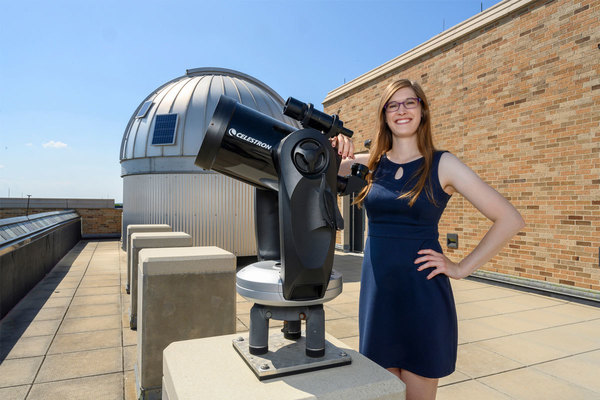
The third time was the charm to receive a highly competitive grant for Michelle Berg, a doctoral student in astrophysics at the University of Notre Dame.

In 2017 and 2018, she submitted a proposal to the Future Investigators in NASA Earth and Space Science and Technology (FINESST) competition, formerly the NASA Earth and Space Science Fellowship (NESSF), only to come up a bit short each time. But this year, she landed the grant, for two years of funding to study the role of gas in shaping galaxies.
The program received 966 proposals, with 188 of those in the astrophysics division. Only 21 proposals, including Berg's, were funded.
Galaxies are known to form stars when they are younger, but as they age, many stop. “To keep forming stars, you need gas coming in. So we characterize the gas flows around galaxies to try to determine how a galaxy goes from forming stars to not forming stars – it’s one of the big questions the community is wrestling with,” Berg said.
Berg will complete her research at Notre Dame, and is using the Hubble Space Telescope, the Keck telescope and the Large Binocular Telescope to study the theory that the environment of high-mass galaxies chokes off the supply of cold gas that is needed to make new stars.
“The most novel part of Michelle’s thesis is to study those galaxies directly, trying to test whether this prediction is true,” said Jay Christopher Howk, professor in the Department of Physics.
The grant will pay for Berg’s final two years of her doctoral program, and she’ll have a bit of extra money available that will fund her attendance at a couple of additional astronomy conferences. Berg said she doesn’t know what her ultimate goal is after she finishes her degree, but that she loves researching interesting questions.
“I might like to work at the Space Telescope Science Institute, because they’re the ones in charge of all the observatories,” she said. “I think that would be really cool, to use all the instruments and also to work there.”
Howk said he suspects her research was chosen by the FINESST committee because her experiment is well designed and addresses specific aspects of a theory, and because Berg produced several pilot studies to demonstrate that her ideas could work on a larger scale.